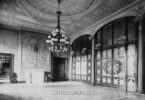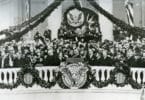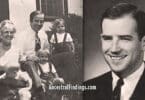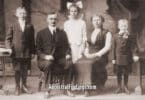Herbert Hoover, the 31st President of the United States, stands as a figure of resilience and complexity in American history. Known primarily for leading the nation during the onset of the Great Depression, Hoover’s life story is deeply rooted in his early experiences, family background, and the values of self-reliance and service that shaped his leadership. Born on August 10, 1874, in West Branch, Iowa, Hoover was the first U.S. president born west of the Mississippi River—a fitting marker for a man whose life was shaped by the pioneer spirit of westward expansion.
A Quaker Family Foundation
At the heart of Hoover’s genealogy is his Quaker upbringing, a faith known for its commitment to peace, simplicity, and service to others. His father, Jesse Hoover, came from a line of Quaker blacksmiths and farmers who had settled in Ohio after immigrating from Germany in the 18th century. The family name, originally “Huber,” was Anglicized to “Hoover” when they moved to America, reflecting the blending of cultures in the new world. Jesse Hoover established a blacksmith shop in West Branch, Iowa, which allowed him to provide a comfortable life for his growing family. He was known as a hardworking and generous man who exemplified the values of honesty and self-reliance.
Herbert’s mother, Hulda Randall Minthorn Hoover, was a devoted Quaker from a family with roots in both Canada and New England. Her parents had been early settlers in the Oregon Territory, embodying the westward movement of the American frontier. Hulda was a deeply religious woman who was actively involved in the Quaker meeting house and committed to community service. She instilled in her children a sense of duty, charity, and faith. These Quaker values would profoundly influence young Herbert’s character and, later, his political philosophy.
Early Loss and the Road to Resilience
Despite the stability of his early years, Hoover’s childhood was marked by profound tragedy. In 1880, when Herbert was just six years old, his father Jesse passed away suddenly from a heart attack. This loss was a devastating blow to the family, but they found solace in their Quaker faith and the support of their community. Hulda Hoover worked tirelessly to raise her three children alone, taking on work as a seamstress and midwife. However, only three years later, in 1884, Hulda herself fell ill and died of pneumonia, leaving Herbert and his siblings orphaned.
At the age of nine, Hoover was sent to live with his maternal uncle, Dr. John Minthorn, in Newberg, Oregon. Minthorn was a Quaker physician and educator who took an active role in shaping young Herbert’s education. Hoover described his uncle as a stern but fair figure who provided him with the structure and discipline he needed during these difficult years. Living in Oregon introduced Hoover to new opportunities and a broader understanding of the world. His upbringing in a rural Quaker environment, where simplicity and hard work were central, was balanced by Minthorn’s emphasis on education and self-improvement.
Education and Early Career
Hoover’s early education in Oregon set the stage for his later achievements. He attended the Friends Pacific Academy (now George Fox University), a Quaker school, where his natural talent for mathematics and engineering began to emerge. Despite the hardships of his early life, Hoover remained determined to succeed. In 1891, he enrolled at Stanford University as part of its inaugural class, majoring in geology. This was a pivotal moment for Hoover, as Stanford provided him with not only an education but also a community of peers and mentors that would shape his future.
After graduating, Hoover began a career as a mining engineer, quickly gaining a reputation for his skill and expertise. He traveled extensively, working in Australia, China, and London, and by the age of 40, he had amassed considerable wealth. His success in the mining industry allowed him to retire early from business and focus on public service, where his Quaker values of charity and humanitarianism would shine.
Humanitarian Work and the Path to Politics
Hoover’s international experience and engineering skills were soon put to use in a different way—humanitarian work. When World War I broke out, Hoover was in London, and he quickly volunteered to lead efforts to help stranded American tourists return home. This effort, which helped over 120,000 people, marked the beginning of Hoover’s lifelong dedication to humanitarian causes. His most notable achievement during the war was his leadership of the Commission for Relief in Belgium, where he coordinated the delivery of food and supplies to millions of civilians caught in the conflict. His tireless work in Europe earned him the nickname “The Great Humanitarian.”
Hoover’s success in organizing large-scale relief efforts brought him to the attention of President Woodrow Wilson, who appointed him head of the U.S. Food Administration in 1917. Hoover’s role was to manage food production and distribution during the war, encouraging Americans to conserve food through voluntary rationing—a concept known as “Hooverizing.” His reputation as an effective administrator and a man of action positioned him for a future in public office.
The Presidency: Triumphs and Challenges
In 1928, Hoover’s extensive experience in business, engineering, and humanitarian work propelled him to the presidency. He ran as the Republican candidate, promising to continue the economic prosperity that had characterized the 1920s. Hoover won the election easily, but within a few months of his inauguration, the stock market crashed, marking the beginning of the Great Depression. The economic catastrophe that followed would overshadow Hoover’s presidency and define his legacy.
Hoover’s response to the Depression was shaped by his belief in individualism and self-reliance, values he had learned from his Quaker upbringing. He was hesitant to use federal power to directly intervene in the economy, instead promoting voluntary cooperation between businesses and government. However, as the economic situation worsened, Hoover’s approach was criticized for being insufficient. Despite his best efforts, including the creation of public works programs and the establishment of the Reconstruction Finance Corporation, Hoover was unable to halt the downward spiral of the economy. By the time he left office in 1933, the Depression had reached its darkest days.
Post-Presidency and Legacy
After leaving the White House, Hoover continued his humanitarian work, focusing on international relief efforts and advocating for the restructuring of the U.S. government. He became a prolific writer, publishing books on economics, government reform, and his own experiences in public service. Though his presidency is often remembered for the economic struggles of the Depression, Hoover’s post-presidential years helped rehabilitate his image as a statesman and humanitarian.
Herbert Hoover died on October 20, 1964, at the age of 90. He lived long enough to see his legacy re-evaluated, with many recognizing his contributions to public service, both before and after his presidency. His life, marked by early hardship and a relentless drive to serve others, remains a story of resilience and commitment to values that he held dear throughout his life.
Here are a few highly recommended books about Herbert Hoover for further reading:
“Herbert Hoover: An Extraordinary Life in Extraordinary Times” by Kenneth Whyte – A well-researched and engaging biography that offers a nuanced look at Hoover’s life, focusing on his contributions both before and after his presidency.
“Herbert Hoover: A Life” by Glen Jeansonne – This biography delves deeply into Hoover’s personal and professional life, painting a portrait of a misunderstood leader.
“Herbert Hoover: A Biography” by Eugene Lyons – This older biography provides a thorough examination of Hoover’s early career, humanitarian work, and presidency.






